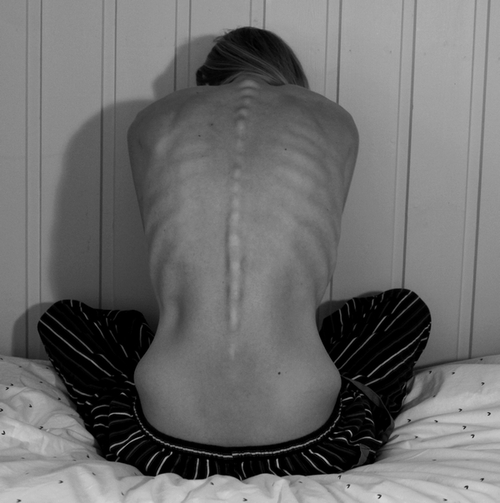Everything You Need To Know About Binge Eating

Bulimia, strictly called bulimia nervosa, is an eating disorder characterised by cycles of binge eating and vomiting or purging using laxatives, diuretics, enemas or other medications. (Laxative: substance that speeds up bowel movement. Diuretic: increases urine secretion. Enema: substance placed in rectum to stimulate bowel movement.
Excessive exercise is regarded as a means of compensation for binge eating. One can have a diagnosis of bulimia nervosa with bingeing and excessive exercise alone.
The severity and frequency of the symptoms of bulimia vary a great deal. At the one end of the bulimic continuum there are women who regularly, but very infrequently vomit, use laxatives or diuretics if they feel uncomfortable after a very large meal. At the other end of the continuum there are women who spend most of the day and every day almost continuously overeating and vomiting, abusing laxatives and diuretics and exercising until they fall asleep exhausted. Most women suffering from bulimia fall somewhere on the continuum between these two extremes.
People with bulimia often starve themselves for long periods in order to compensate for overeating.
These symptoms can cause serious physical problems, such as damage to teeth by the action of gastric juices on the enamel, loss of hair, throat haemorrhages and damage to vocal chords, damage to the lining of the stomach, strain to the heart and breaking of blood vessels in the eyes and face, and dangerous lowering of potassium levels.
Furthermore, the loss of electrolytes such as potassium chloride and sodium during bulimic behaviour can lead to cardiac rhythm irregularities, kidney dysfunction, neurological abnormalities or sudden death.
There are two types of bulimia recognised:
- The purging type – in which the person regularly self-induces vomiting or misuses laxatives, diuretics or enemas.
- The non-purging type – in which the person uses other forms of inappropriate behaviour to compensate for over-eating, such as fasting or excessive exercise, but does not regularly engage in self-induced vomiting or the misuse of laxatives, diuretics or enemas.
Causes
The true cause of bulimia is not known, but there is some evidence to suggest that serotonergic, noradrenergic and endorphin dysfunction may be involved in development of the condition. This could possibly have some hereditary component. It is not so much that the causes are not known, but rather that the aetiological factors are usually numerous and interacting. The neurochemical factor should not be overplayed.
Eating disorders in general also have a known association with the modern Western obsession with slimness as a mark of beauty and success. Furthermore, the changing status and expectations of women in society seem to play an important role in the increase in women suffering from eating disorders. Although many factors may contribute towards the development and/or maintenance of bulimia, there is evidence that suggests that the family environment plays an important role in the development and/or maintenance of bulimia.
Who gets it and who is at risk?
Estimates of the incidence and prevalence of eating disorders are variable. However, studies have suggested that between 1.1% and 4.2% of women will suffer from bulimia at some time in their lives. Eating disorders in general are more common among women, and bulimia is no exception, with a male to female ratio of 1:6 to 1:10.
One of the reasons that bulimia is significantly more common in women than in men is that the emphasis on thinness for males is less demanding than for females. The age of onset varies, but bulimia is most common in women aged 14 to 30.
Risk factors are difficult to determine. Predisposing risk factors include depression, anxiety, obsessive compulsive behaviour, borderline personality disorder, as well as sexual and physical abuse. Furthermore, there is evidence to suggest that in some people excessive exercise may precipitate the eating disorder. Female athletes in certain sports such as distance running and gymnastics are particularly vulnerable because they need to maintain a very low body weight. Certain professions such as modelling, acting and dancing dictate that the women meet unreasonable weight standards that cause disordered eating patterns to emerge.
Both anorexia and bulimia share several common features. For example, in most women suffering from bulimia episodes of binge eating are substituted with periods of extreme dieting, self-induced vomiting and/or use of laxatives. Preoccupation with weight and fluctuations in body-weight are also common features of anorexia. In essence, the symptomatic features, psychological features and cause and natural history of these two syndromes overlap to a significant degree. The criteria for bulimia nervosa were only developed in the early 1970s by British psychiatrist, Prof Gerald Russell.
Symptoms and signs
The symptoms and signs of bulimia include:
- Recurrent episodes of binge eating – this is generally defined as eating more in a short period of time (less than two hours) than most people would eat under the same circumstances.
- A sense of lack of control over the eating.
- Vomiting, misuse of laxatives, diuretics, enemas or other medications, fasting or excessive exercise are then used to try to compensate for any weight gain as a result of the binge.
- The person has a distorted idea of her/his body shape and size and evaluates herself/himself in terms of weight and size.
Warning signs
- Visiting the toilet soon after meals (often you will hear the sound of running water to hide the sound of vomiting);
- Depressive moods;
- Strict dieting followed by increased criticism of body size or shape;
- Difficulty swallowing and retaining food;
- Puffiness around the face (below cheeks);
- Sudden appearance of acne;
- Damage to the throat;
- Headache;
- Dizziness and petty stealing of money to buy food for binges;
- Increased impulsive behaviour and/or argumentativeness;
- Possible increase in drug use.
Diagnosis
As with most psychiatric problems, a list of criteria which are found in a manual called the DSM4-R are used to reach a diagnosis. These criteria are essentially the same as the symptoms and signs listed above. A person who shows most or all of these symptoms and signs will be diagnosed as having bulimia.
For a definite diagnosis, all of the following should be present:
- The person must show a persistent preoccupation with eating and an irresistible craving for food. The person suffers from episodes of overeating in which large amounts of food are eaten in a short time.
- The person then attempts to counteract the fattening effects of the food by self-induced vomiting, laxative abuse, episodes of binge-eating that are substituted with periods of extreme dieting, and/or use of drugs such as appetite suppressants, thyroid drugs or diuretics. Diabetics with bulimia may not take their insulin.
- Excessive exercise.
- The person suffers from a morbid dread of being fat and sets themselves a sharply defined weight threshold, well below so-called normal weight.
Prevention
Since the true reason for the development of bulimia is not known, it is difficult to say how it can be prevented. However, since we live in a society where the “ideal” woman portrayed by the media is far from realistic, educators and parents can do a lot to put that “ideal” picture into perspective. Adolescents must be helped to understand that appropriate body weight does not equal extreme thinness.
How parents can help:
First of all, parents should set good examples for appropriate eating and exercise patterns. If a mother feels good about herself, she will convey a positive body image to her daughter. Furthermore, children must be taught to respond to hunger rather than environmental or emotional cues for eating. Hunger can be classified as appetite (gastric hunger) and emotional hunger. Parents should avoid placing moral values on food – classify them as “sometimes” and “always” foods rather than “good” and “bad” foods.
Educators should provide information about the normal physical changes that occur during puberty and discourage fad diets and meal skipping. They should also encourage a healthy approach to weight loss, healthy exercise and moderate eating. Also, the family should try to spend as much time as possible eating meals together. Meals should be regular (three meals and two to three snacks a day).
Treatment
There are three main interventions:
- Nutritional rehabilitation and counselling – this focuses on correcting unhealthy eating patterns and behaviours which are related to the eating disorder, and may be used together with other treatment methods. The idea is to minimise food restriction, increase the variety of foods eaten and encourage healthy, but not excessive, exercise.
- Psychosocial intervention – each patient needs to be carefully evaluated as to their psychological and intellectual development, any other psychological or psychiatric problems and their family situation. There is evidence to show that cognitive behavioural or psychodynamic psychotherapy is helpful once the bingeing and purging are starting to improve. Wherever possible, family therapy should be considered, particularly for teenagers still living with parents or older patients who have problems with their family relationships.
- Medication – many people with bulimia benefit from antidepressants. This is particularly true at the start of treatment. The selective serotonin reuptake inhibitors (SSRI’s), such as fluoxetine, are thought to be the safest and most effective. They are specifically useful in patients who also suffer from depression and anxiety or who are obsessive in nature.
It seems that the most successful approach at present is a combination of psycho-education, nutritional advice, psychotherapy and medication.
Outcome
There are many physical complications of bulimia due to the body’s response to the binge-purge cycle:
- The person may become weak and irritable, and suffer from abdominal pain and discomfort. Constipation and bowel irregularity is a common complication.
- Women may suffer from problems with fertility and menstrual irregularities. Production of the hormone oestrogen may be reduced.
- The constant vomiting can cause dental decay and erosion and enlarged salivary glands . Laxative abuse can cause serious colon damage.
- In severe cases there may be changes in electrolytes (substances that conduct electric currents for important physiological processes in the body) such as potassium and sodium. This will may lead to problems with the heart and other muscles.
Very little is known of the long-term prognosis of patients with untreated bulimia.
The overall short-term success rate for patients receiving psychotherapy treatment or medication has been reported to be 50-70%. Relapse rates of between 30% and 50% after six months to six years years of follow-up have been reported for patients who were able to successfully complete a treatment programme.
There is some evidence to suggest that slow improvement continues if the patient is followed up on an on-going basis of 10 to 15 years when relapsing after successfully completing treatment.
Patients who have good social functioning and relatively mild symptoms at the start of treatment generally do better than those whose symptoms are severe.
When to call the doctor
If you, or any member of your family develops a morbid preoccupation with weight and size and appears unduly interested in food, you should consult your doctor as soon as possible. Eating disorders so often have a negative outcome if treatment is postponed. The GP is one option from which to start, but a dietician or clinical psychologist specialising in the treatment of eating disorders might be even better.





